# How to use Vue components in custom plugins
A plug-in is a carrier for controlling the system process. Components developed in the Vue framework can be used in the plug-in to encapsulate the functions and interactions of the fields. This article describes how to use Vue components in custom plugins.
# premise
Before learning how to debug custom plugins, you need to know:
- The custom plug-in is developed based on the javascript system
# manual
1. Develop Vue components
The file name is: name.vue
<template>
<div>
这是自定义字段
<input type="text" @change="_change">
</div>
</template>
<script>
export default {
methods: {
_change(e) {
this.$emit('change', e.target.value);
}
}
}
</script>
2. Develop plugins
import FieldName from './name.vue';
export default {
entry(context, field) {
return field.api_name === 'name';
},
render(context) {
return new Vue({
render(h) {
return h(FieldName, {
on: {
change: this._onChange
}
});
},
methods: {
_onChange(val) {
alert(val);
context.setValue(val);
}
}
}).$mount().$el;
}
}
3. Upload the plugin and debug it.


